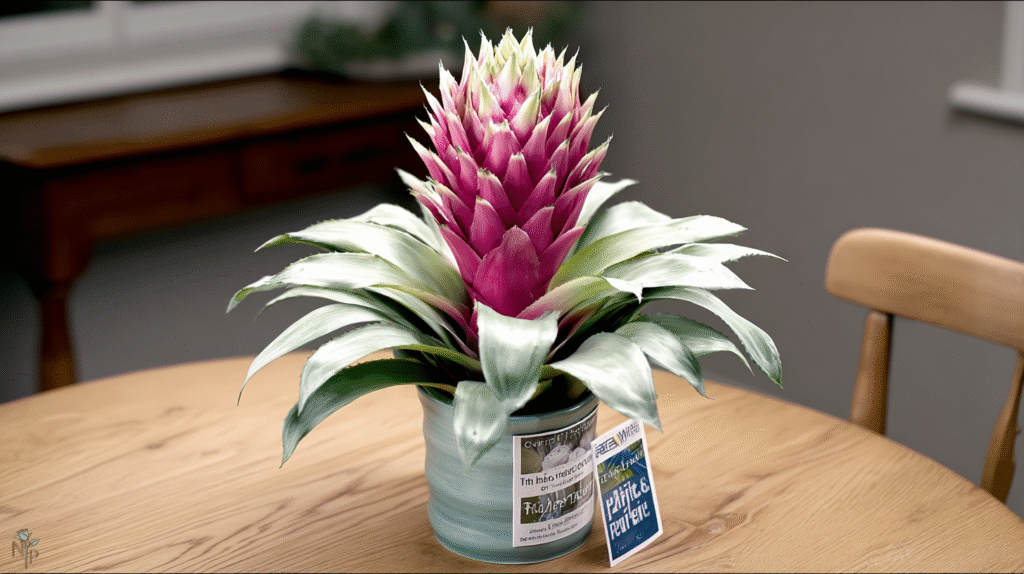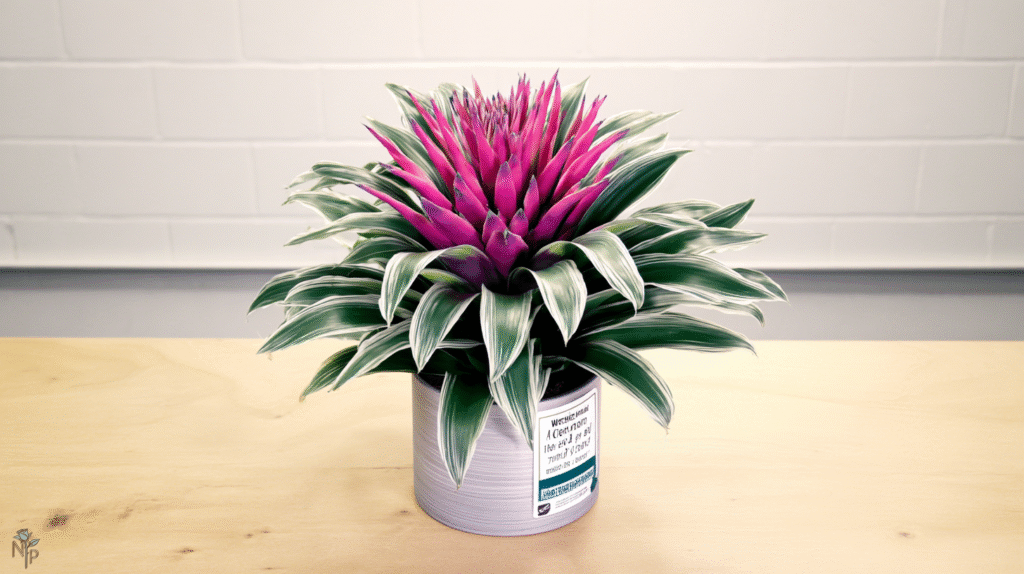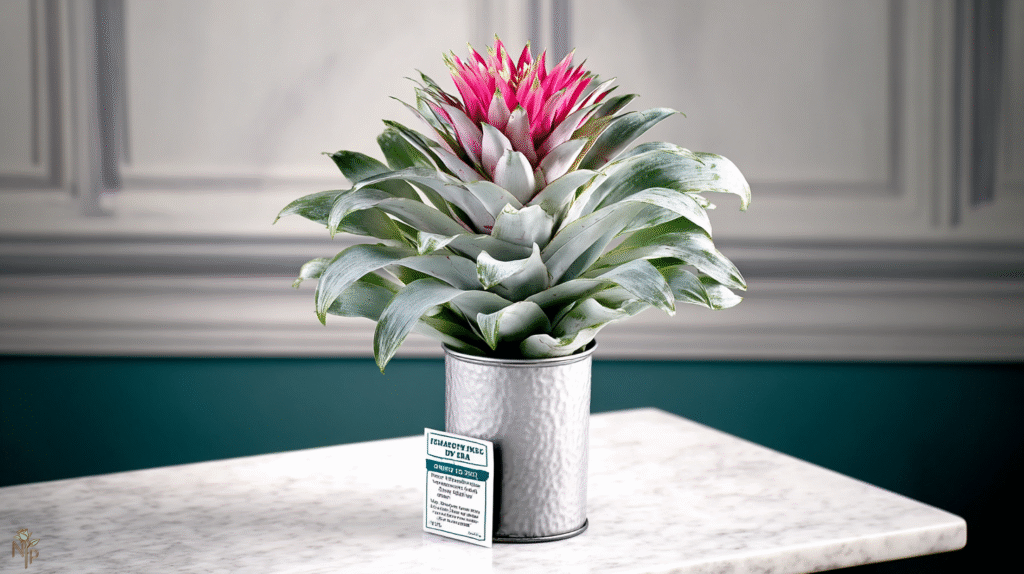I brought a bromeliad to a housewarming party once. Everyone else brought wine or candles. The host literally gasped when she saw it – this bright pink torch rising from silvery-green leaves, looking like it belonged in a tropical resort, not wrapped in cellophane from Trader Joe’s.
“I’ll definitely kill this,” she said. That was two years ago. Not only is it still alive, but it’s produced three babies that she’s given away, making her look like some kind of plant goddess. Meanwhile, the person who brought the orchid? That thing was dead in a month.
Here’s the secret nobody tells you about bromeliads: they’re nearly impossible to kill but look like they require a horticulture degree. They’re basically the designer handbags of the plant world – impressive-looking but surprisingly practical. After giving away probably twenty of these as gifts (and keeping five for myself because I have no self-control), I’ve learned exactly how to set people up for success.
Why Bromeliads Make Everyone Think You Spent $$$
First off, let’s talk about perception. A bromeliad looks expensive. That architectural shape, those bold colors, that exotic vibe – people assume you dropped serious cash. Reality? I usually pay $12-20 at the grocery store. But next to a sad $8 pothos, a bromeliad looks like you really made an effort.
The pink ones (Guzmania) look like tropical flowers that last forever. The silver ones (Aechmea) look like living sculptures. The striped ones (Vriesea) have patterns that seem hand-painted. Put any of these in a decent pot and suddenly you’re the friend who gives “thoughtful, unique gifts.”
I once brought a $15 bromeliad to a dinner party where someone else brought a $60 bouquet. Guess which one got more compliments? Guess which one is still alive?

The Care Instructions That Actually Work
When I give a bromeliad, I include a little card with care instructions. Not the vague nonsense from the store tag, but real instructions that work:
“Water the cup, not the soil” This blows people’s minds. That natural cup formed by the leaves? That’s where water goes. Fill it once a week, dump and refill monthly. The soil should be barely moist. I watched my sister water hers like a regular plant for months, wondering why it looked sad. Showed her the cup trick – instant improvement.
“If you forget to water for a month, it’s fine” This is the selling point. Forgot to water while on vacation? Bromeliad doesn’t care. Forgot it existed for three weeks? Still good. My coworker ignored hers for six weeks during a work crisis. Filled the cup when she remembered, it perked right back up.
“Brown tips are normal, not failure” Everyone panics about brown leaf tips. It’s just age or tap water minerals. Trim them with scissors if they bug you. The plant doesn’t care. My mom almost threw hers out over some brown tips until I showed her my five-year-old bromeliad covered in trimmed tips but still thriving.
Light Requirements (Easier Than Orchids)
Here’s what I tell gift recipients: “If you can read a book there during the day without turning on a light, your bromeliad will be happy.”
That’s it. No complicated foot-candle measurements, no grow lights, no rotating schedules. My bromeliad in the bathroom with a frosted window? Happy. The one 10 feet from a north window? Also happy. The one my friend put in her windowless office under fluorescents? Still alive after a year.
Direct sun will burn them (learned this when I put one outside “for fresh air”), but they’re way more flexible than orchids or fiddle leaf figs. This makes them perfect gifts because most people don’t have perfect light conditions.
The Watering Method That Impresses Everyone
When I show people how to water their bromeliad, they think I’m some kind of plant wizard. The drama of pouring water into the cup, watching it pool in that natural reservoir – it feels special, intentional. Way more interesting than just dumping water on soil.
The technique that keeps them alive:
- Fill the cup (technically called a tank) with water
- Let a tiny bit overflow to barely moisten the soil
- Empty and refill the cup monthly to prevent stagnation
- Use filtered or rain water if your tap water is super hard
My tap water is basically liquid limestone, so I keep a jug of filtered water for my bromeliads. The difference in leaf tips is obvious – filtered water means fewer brown tips, which means the plant looks better longer, which means the gift recipient thinks they’re amazing at plants.
Temperature and Humidity (They’re Not That Picky)
Every care guide says bromeliads need high humidity and perfect temperatures. My apartment in winter is drier than stale crackers and swings from 62°F at night to 74°F during the day. All five of my bromeliads are fine.
Would they prefer 70°F and 60% humidity constantly? Sure. Do they need it? Absolutely not. The only time I’ve seen temperature matter is when my friend put hers outside during a cold snap. It survived but looked rough for months.
For gift-giving, this flexibility is gold. You’re not giving someone a demanding plant that needs special conditions. You’re giving them something that adapts to normal house conditions.
The Blooming Secret Nobody Mentions
That bright colorful spike everyone loves? It lasts for MONTHS. Like, 3-6 months. Compare that to cut flowers that last a week or an orchid bloom that might last 6 weeks if you’re lucky.
But here’s what I always warn people: once that bloom fades, it won’t bloom again. That specific plant is done blooming forever. People think they’ve killed it when the bloom dies. Nope, totally normal.
The magic happens next – babies (called pups) start growing at the base. These will eventually bloom, but it takes 1-2 years. I tell gift recipients to think of it as getting multiple plants for free. My original bromeliad has produced four pups over three years. That’s four future gifts or trades.

Potting and Soil (Don’t Overthink It)
Bromeliads barely use their roots. In nature, they grow on trees, using roots just for anchoring. This means two things for gift-giving:
- They don’t need repotting for years (one less thing to worry about)
- Regular potting soil is too heavy
If someone asks about repotting, I tell them to use orchid mix or mix regular potting soil with lots of bark and perlite. But honestly? I’ve had one in the same pot with the same soil for four years. It’s fine.
The only time repotting matters is when separating pups, which is optional. My friend has a giant cluster of mother plant and three pups in one pot. Looks amazing, zero maintenance.
Common “Problems” That Aren’t Problems
“The flower is turning brown!” Normal. It lasted months, now it’s done. Cut it off when it’s fully brown.
“There’s water sitting in the cup!” That’s literally the point. That’s how they drink.
“Tiny bugs in the water cup!” Mosquito larvae sometimes happen. Dump the cup, rinse, refill. Problem solved.
“It’s not growing!” They grow super slowly. Like, glacially slowly. Not dying = success.
How to Present It Like a Pro
When I give a bromeliad as a gift, presentation is everything:
The pot upgrade: Those plastic nursery pots are ugly. I spend $10 on a nice ceramic pot and suddenly it’s a $30-looking gift.
The instruction card: I make a little card with care instructions in simple terms. Makes me look thoughtful and sets them up for success.
The confidence boost: I always say, “These are way easier than they look. If it’s alive in six months, you’re doing everything right.”
The selection: Pink for people who like flowers, silver for the minimalists, striped for anyone who appreciates patterns.

Why I Keep Giving These as Gifts
Last month, I visited three friends who have bromeliads I gave them over the past two years. All three plants were alive. One had produced pups, one was in a bathroom being used as decor, one was on a kitchen counter adding “tropical vibes.”
Compare that to the orchids, African violets, and fancy begonias I’ve given that are now definitely dead. Bromeliads make me look like a thoughtful gift-giver and make the recipients feel successful at plants. Win-win.
The best part? When they text me months later saying “it’s still alive!” or “it made a baby!” they’re genuinely excited. That $15 plant from Trader Joe’s created an actual lasting positive experience.
My only warning: once you give someone a bromeliad that survives, you become the designated “plant gift” person. I’m now expected to bring plants to every gathering. There are worse reputations to have, I guess.
Just remember the golden rule of bromeliad gifting: include those care instructions. The difference between “exotic plant that died immediately” and “I can’t believe it’s still alive!” is literally just knowing to water the cup, not the soil. That one piece of information turns a potential guilt-inducing gift into something that makes people feel capable and successful.
And really, isn’t that the best kind of gift? Something beautiful that makes the recipient feel good about themselves every time they look at it, months after you gave it to them?






